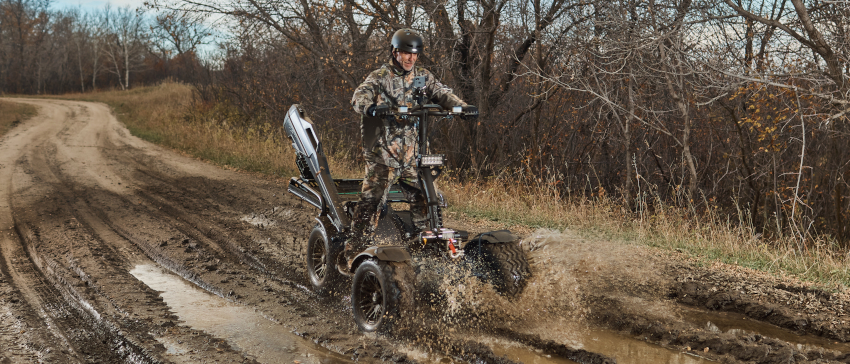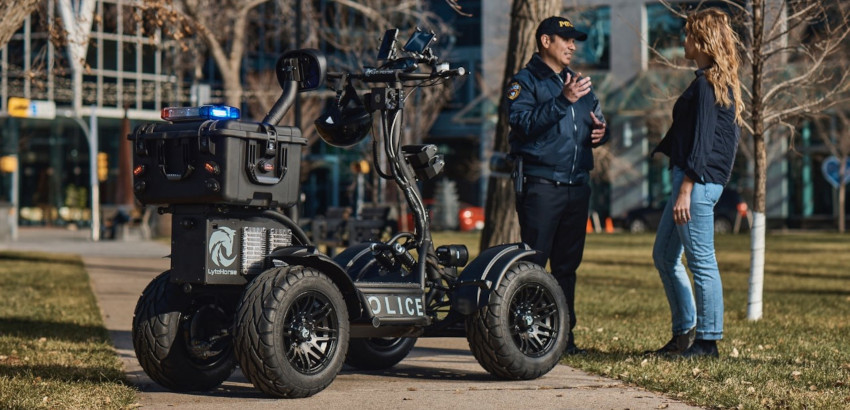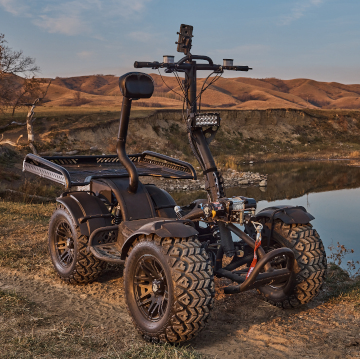
Off-Road EV Scooter
By Thomas Renner
General SustainabilityRegina, SK-based LyteHorse Labs’ all electric ATV designed to tear up treacherous terrain.

The all-electric LyteHorse ATV boasts a top speed of 65kph and a range up to 129 kilometers.
(Photo credit: LyteHorse Labs)
A new ride is quickly gaining traction in the growing electric vehicle market. Initially crafted as a potential alternative to golf carts, designers at LyteHorse took the concept and created an electric stand-up ATV that can be used in multiple work and recreation environments.
Saskatchewan-based LyteHorse Labs designed the electric stand-up all-terrain vehicle, which has a maximum range of 129 kilometers (80 miles) and the ability to reach a top speed of 64 kph (40 mph).
In addition to its obvious recreational appeal, the company has developed the stand-up ATV to suit utilitarian applications, including law enforcement, military, fire and rescue, warehouses, airport and border security.
“The form factor of LyteHorse vastly re-imagines the power and utility of the ridden horse, with future-proof materials, technology and performance that will change the way electric mobility can be applied,’’ said Allen Bonk, CEO of LyteHorse Labs.
To create the original prototype for this vertical riding machine, Brad Bonk, Allen’s brother and co-founder of LyteHorse, used an electric motor from a washing machine, battery and controller attached to a chassis. The brothers tested it on the golf course.
“It was way more fun than golf carts,” Allen said. “It soon became obvious that there were significant utility applications for it, and there was a definite gap in the marketplace for an easy access, stand-up ATV.”
The Bonk brothers realized the utility vehicle could have broader applications when they discovered it could tow a two and a half-ton SUV.
“After taking it to the golf course, Brad and I decided to hook up the prototype to my SUV to see if it could pull the car,” Allen said. “And yes, that crazy little scooter ended up towing a 2.5 ton SUV across the car park.”
The production LyteHorse has towing capacity of 1,500 pounds, the company says. That extra capacity allows it to carry additional battery packs, which boost the vehicle’s travel range to 579 kilometers (360 miles), if needed.

Beyond its obvious recreational uses, the LyteHorse is also highly configurable to suit a number of applications, including police, fire and search and rescue.
(Photo credit: LyteHorse Labs)
The LyteHorse is another example of the expanding electric mobility market. According to a report from McKinsey, 2020 was a banner year for electric-vehicle sales. In the fourth quarter, sales of EVs grew 60 percent globally and 80 percent in China. In the United States, EV sales increased nearly 200 percent between the second quarter of 2020 and the second quarter of 2021.
LyteHorse Labs stands poised to tap into the emerging EV market, in large part due to the range of applications for which its product can be used. More than 20 mobility related industries can be made easier and better with LyteHorse, Allen said. In addition, units can also be customized with racks, lighting and other features, depending upon the application.
While it took several years and many iterations to develop the final product, Allen Bonk believes the LyteHorse will be a game-changing ride for the electric mobility market.
“It has definitely exceeded all expectations,” he said. “The machine is a beast and incredibly robust. The applications are endless.”
Brad Bonk has more than 40 years experience building and repairing motorcycles, cars and hot rods. When the brothers realized the machine they were designing had such a wide range of applications, they developed different iterations of the LyteHorse.
“There was a lot of trial and error,” Allen said. “The steering for a stand-up vehicle is extremely complex. Making the suspension work in concert with the steering geometry proved to be very challenging.”
The engineering team designed different models for the various markets. The model called the “LH2” is a twowheel drive version that can be used for recreation, running errands or moving about a resort community. The “LH4” is a four-wheel drive unit that provides maximum stability and traction in the most treacherous terrain. It can be used in more rugged settings, such as hunting areas.
Each unit weighs about 317kg (700 pounds), and operates quietly. Unlike traditional all-terrain vehicles, there is also no scheduled maintenance. In the LH4 model, four independent electric motors power the vehicle, providing up to 24,000 watts of peak power.
To supply that power, the company even designed its own battery pack, the “LytePack,” a 2.4 kilowatt hour pack that provides 20-25 miles per pack. Each LyteHorse can hold up to four packs.
According to the company, its in-house built battery pacts last for up to 2,500 cycles before needing to be replaced; that’s nearly seven years if charged daily. The pack also allows the LyteHorse to operate in temperatures ranging from 40°C (110°F) down to -20°C (-4°F).

Available in 2- or 4-wheel-drive, both LyteHorse models are waterproof to a 2-foot depth and feature heavy duty suspension and a traction control system for added stability.
(Photo credit: LyteHorse Labs)
“It’s very different from a traditional ATV,” Allen said. “It has no drivetrain, no scheduled maintenance and zero sound emissions. Also, it is safer as the LyteHorse tipping point is 67 degrees compared to a typical quad, which is about 37 degrees.”
Each LyteHorse includes multiple parts from igus, the Germany-based manufacturer of motion plastics. “We used igus anywhere bearings would normally have been used,” Allen said. “Suspension arms, steering post, swing arms and suspension posts. The igus bushings have a strong track record of reliability and performance.”
The self-lubricating igus bushings are an important feature of the LyteHorse, as they can stand up in all types of challenging environmental conditions.
While designing the LyteHorse, the company’s engineers initially tested units with steel and nylon bushings, but ultimately selected igus bushings. Made with iglide J material, the bushings provide low wear against different shaft materials and low moisture absorption and good chemical resistance.
“We couldn’t achieve our requirements with conventional bearings because they are susceptible to dirt, salt water and extreme temperatures,” Allen said. “In the end, the flanged bushings we used convinced us that they were the best choice in terms of performance, durability, reliability and cost.”
He added other bearings proved to be too bulky and were prone to failure. “The durability and self-lubricating properties were critical, but they also provided ease of integration,’’ Bonk said.
LyteHorse Labs is working with Detroit-based tier 1 automotive components supplier and engineering services firm, Mayco International, as its production partner.
Currently taking reservations through its website, the company announced recently that it had passed 120 units pre-sold to customers in 30 U.S. states and in eight countries outside North America. It anticipates delivery of those units in the first quarter of 2022. They are also in discussion with distributors and expect dealers to engage early next year.
lytehorse.com
www.igus.ca
Thomas Renner writes on machine design, engineering, construction and other industry topics.
